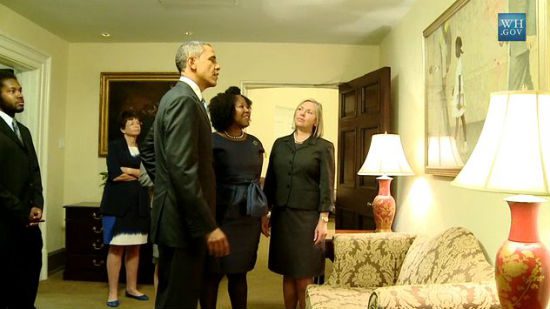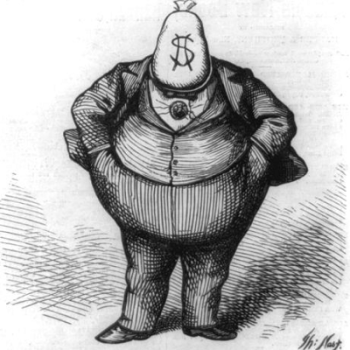I need to finish writing about Buck Williams’ advanced course in How Not to Evangelize, and there’s a lot of other stuff going on in the world that we need to discuss — like the circus in Cleveland — but let me say one more thing about that Duane Litfin piece in Christianity Today we discussed yesterday, “Christians Don’t Want to Stop Serving Their LGBT Neighbors.”
Here’s how that article begins:
America’s culture wars show little sign of letting up. In recent years the federal government’s executive and judicial branches have heated the battle by pressing hard on controversial LGBT issues, including the right to marry. Some state legislatures have followed suit.
Litfin’s framing here is not simply hostile and misleading, but impossible. He is so eager to minimize the legitimacy of LGBT people’s claims to legal and civil equality that he starts from an “activist judges” narrative that fails to grasp even a Schoolhouse Rock-level understanding of how government works. In Litfin’s telling, the “judicial branch” just suddenly decided one day to start legislating from the bench — “pressing hard” to create new “controversial” rights for LGBT people.
That’s not how courts work. Judges don’t introduce cases, citizens do.
Litfin here rhetorically erases those citizens as a way of dismissing the legitimacy of their claims, thereby implying a strange vision of how civil rights cases arise. In Litfin’s system, apparently, one day in 1954, out of the blue, Chief Justice Earl Warren arbitrarily decided to call Oliver Brown of Topeka, Kansas, to inform him that the judicial branch had decided to heat things up by decreeing that his daughter should be allowed to enroll in a better school. And then a few decades later, Judge Vaughn Walker awoke one morning and decided, by fiat, to telephone Kristin Perry and Sandra Stier to let them know that California’s Proposition 8 would no longer prevent them from getting married.
That’s not at all how courts work. That’s not where these cases come from. Oliver Brown wanted his daughter to get an education, but she wasn’t allowed to attend the nearby public school. So Brown filed a lawsuit against the Topeka Board of Education because that board was — lawlessly and unconstitutionally — denying his daughter’s legal rights. The judicial branch did not invent that legal right, it simply reaffirmed it. Perry and Stier sued the state of California because they were denied their equal right to marry. These landmark decisions were not initiated by the judicial branch — the courts don’t get to do that, ever.
Nor were those cases and legal findings the product of “the federal government’s executive branch.” In those cases — as in most of the civil rights cases that upset culture warriors like Litfin — the executive branch’s role was that of defendant, not plaintiff.

More than 60 years later, Litfin will agree with what I just said about the court’s decision in Brown v. the Board of Education. He will agree that Linda Brown already had the right to attend a public school, and that the court was correct to reaffirm that right and to rule that it was illegal and unconstitutional for the Topeka Board of Education to deny her that right.
That idea is no longer controversial. It’s obvious. Yesbutofcourse, everyone know’s that. But everyone didn’t know that in 1954. In 1954, Oliver Brown’s contention that the right to attend public school applied to his daughter — the black daughter of a black man — struck many people as bewilderingly novel and innovative. In 1954, the obvious, yesbutofcourse thing that everyone knew was that the right to attend public schools only applied to white children, because that was just the way things had always been. At the time, Brown and his lawyers were perceived by many as trying to invent some new right, and the court was perceived by many as heating things up and pressing hard by legislating from the bench. In 1954, many people held that view — the same view that Duane Litfin and his friends at Christianity Today hold about the courts’ reaffirmation of Kristin Perry and Sandra Stier’s legal and constitutional right to marry.
If Litfin wants to disagree with the courts — to say that no such legal or constitutional right exists for same-sex couples — then he’s free to do so. He’s free to attempt to explain why the right to marry, or any other civil or legal right, cannot apply equally to LGBT people, and why the courts were wrong to reaffirm such equal treatment. But he hasn’t done that, or even attempted to do that.
Instead, he’s tried to muddy things up by framing legal equality as an illegitimate innovation concocted by activist judges, pretending that the courts initiated all of this and, thereby, pretending that the plaintiffs in these cases — and the millions of other LGBT citizens they represent — don’t matter or don’t even exist.
That’s wrong — factually and morally. It’s the kind of wrongness that suggests maybe the best thing for Duane Litfin to do might be to close his mouth, put down his pen, and go away for a little while to sit quietly to think for a bit before he disgraces himself any further.












